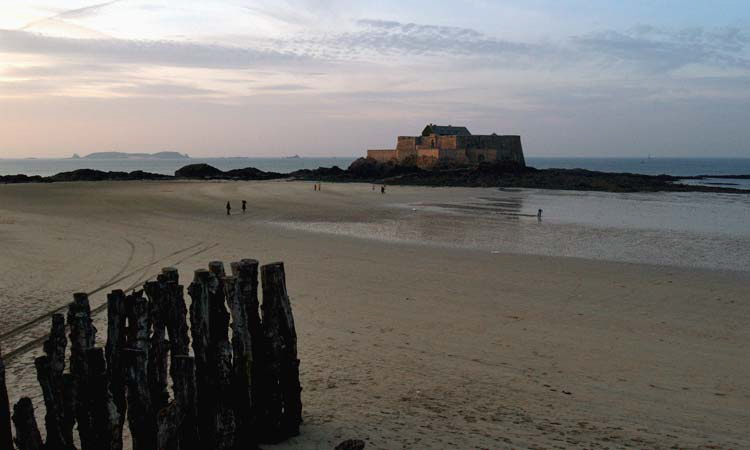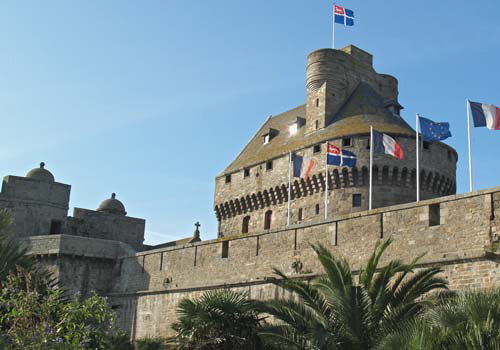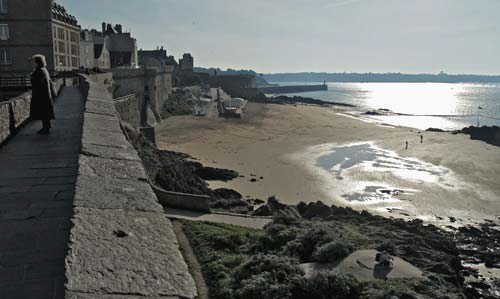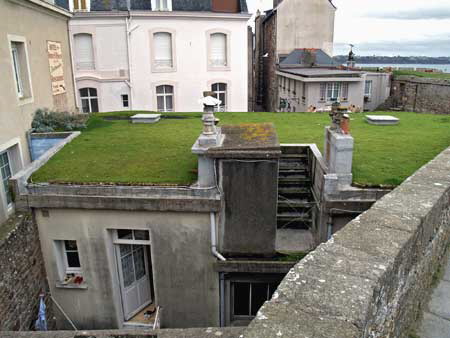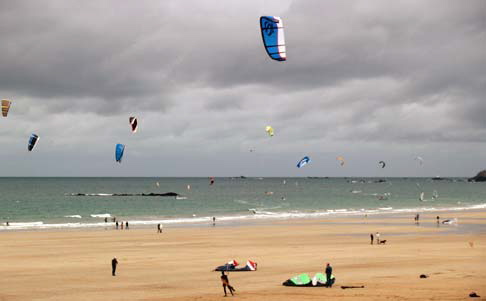|
Just Above Sunset |
|||
|
|
|||
|
|
|
|
The photographs follow the text - scroll down. |
|
Our Man (not) in Paris - Hot Chocolate and Oatmeal Cures All Paris, November - After another long pause stinky food time was here again. Instead of going to someplace around here to snort the cheeses, I wandered far afield. A very good friend of mine has a theory that a cure for all ills can be found in a cup of hot chocolate and a bowl of oatmeal, especially if taken at four in the morning at the Café Saint Malo in Montparnasse. Well, I thought, what's good in Montparnasse might be better in the original, in Saint Malo itself. I learned by purest chance that there is a SNCF ticket boutique in a nearby minimall, local home of Tati and Darty, and in it there were promo signs. One said, "Weekend in Saint Malo, from 25€" so when my turn came I simply pointed at the sign. The ticket lady, an otherwise fine person, merely laughed. "That promo does not go into effect until two days after you leave this office," she said, without a trace of irony. Same thing for the so–called 'senior' discount. You have to pay 53 euros per year for it. "For one lousy trip to Saint Malo?" She said, "Ha ha." You only live once no matter what it costs, so I bought some pricey tickets. My very good friend was very excited about this rare excursion so we got to the station very early, which wasn't all that hard because it is in Montparnasse too. It is the gateway to Brittany, as anybody who has ever had oatmeal at four in the morning in the rues Delambre or Odessa or the Café Saint Malo will doubtless remember. The trip, on a TGV train, was fast and uneventful. The train stopped in Rennes – Capital of Brittany! – for five minutes and again in some token jerkwater burg, and then it glided into the station at Saint Malo, about three hours distant from Boggleville. The old station is close to the town centre but the new station, made out of cardboard and glass, is further away. The first five passengers off the train took all the three taxis. But the sun was shining, clouds were scooting around the sky - which was all over - and the strong winds weren't too overwhelming. With the help of a broken interactive map we found our way to our hotel, which happened by sheerest chance to be located overlooking a monster beach and its low tide. Later, in the room, we could even see the sea - actually, the Channel - by leaning out and craning our necks dangerously. But we weren't in Saint Malo to hang around in our totally nondescript three-star room with cable-TV and free books to read in the lobby, in Italian no less. Instead we crossed the Chaussée de Sillon to get a good view of the Grande Plage, a sandy otto several kilometres long and getting wider as the tide went out to wherever it goes. With a fresh breeze in the face - I have mentioned these Channel breezes before I'm sure - we stumbled towards downtown on the bricks that pass for sidewalk paving next to a sea wall made of stout stone blocks. Off in the near distance we could see some sort of fort on a rock, curiously named Fort National. It will stick forever in my memory. To avoid confusion later on, let me describe Saint Malo. Out in the sea, the Channel actually, behind tiny islands named Fort du Petit Bé and Le Grand Bé, there is a headland called Intra–Muros and behind it there is a semi–circle of water for boat parking, and inside this there is a pond called Bassin Jacques Cartier for more boat parking. Some boats park outside where it's rougher, but they don't like it. This Intra-Muros place is the old, fortified town. Except it is not all that old, most of it, because it was blown to smithereens in WW2. Rather than rebuild it out of plywood and extruded aluminum the Saint Malo folks liked it the way it was, so they rebuilt it that way, stone by bloody stone. If you like stones - blocks, cubes, boulders - you'll love Saint Malo. The whole thing is stone except the sky. The first big pile I saw was the Hôtel de Ville which is a fierce–looking castle, flying all sorts of flags, with palm trees below its ramparts. It looks like a place that stands no nonsense from its disaffected citizens. A lady running it said it had nothing to do with tourist information. "Past the drawbridge, the portcullis and the moat, turn left and then straight ahead," she said. And she did not mean the weather–proofed municipal merry–go–round. The motto of Saint Malo is Cité Corsaire. In a bizarre twist of fate Saint Malo was named after a Welsh monk named MacLow sometime around the 6th century when he established his bishopric - ha, ha - a stone's-throw away. The city as it is now, was piled up stone-by-stone in the 12th century, because its Malouins were cleverly catching enemy ships. They were swearing in 1308 and in later on they swore at Charles VI, who said they were free to rob and pillage. To keep these louts in line the Duchy of Brittany built the castle, which the crafty Malouins proceeded to capture in 1590, and then they declared that they were republicans. This lasted a whole four years until Henry IV became a Catholic through another crazy twist of fate. Then Jacques Cartier discovered Canada behind Newfoundland and the rest is history. But there's more. The city burnt down in 1661 and it was rebuilt, with bigger stones. Thanks to its shipowners and sailors the city enjoyed prosperity in the 17th and 18th centuries, including notorious privateers like Duguay-Trouin and Surcouf. They had to turn legit in 1815 when Napoléon was taken out. Because of the WW2 bombs and because of fires, Saint Malo was rebuilt out of granite instead of being half–timbered like it was before. A couple of timbers have been left in place for wood fans, however. Despite these tiny vestiges, Saint Malo is a very solid place. It can take anything the sea can toss against it. And the sea is right at the doorstep, with tides letting salt waters lap at the very walls. Entering the town by the ancient Porte Saint Vincent was a thrill, especially on finding about a dozen restaurants on the Place Châteaubriand, named most likely, after a popular menuitem, created by the personal chef, Montmireil, exclusively for Vicomte François–René de Châteaubriand. François–René was born in Saint Malo and he is apparently buried there because you can visit his tomb, located a long way from his statue. I did not know this when I climbed the ramparts that encircle the city. I saw the sea on three sides, the beaches, several offshore islands, speeding ferry boats, breaking waves, wispy sailboats, receding tides, enchanting mermaids, and idly noted that every second human being was dragging a dog. The very good friend of mine - hereinafter identified as VGFoM - decided, after some 30 minutes in the breezes on the tops of walls, to try some shopping. As a result I can assure you that if you fancy typical Breton blue and white striped sweaters, they are available for modest amounts, as are bottles of local cidre, biscuits, biscuit tins without biscuits, ship's models, brass spy glasses, ships in bottles, rum in bottles, weird pastries, smoker's pipes, ceramics of all sorts, pirate flags, flags of Brittany - nice if you like black and white - and, not least, tins of sardines - none of it made in China. After buying the striped outfit in the striped outfit bag for the month-old baby, we stepped into the greatest sardine shop in the world. I don't know how it happened but when we walked out, staggering, we were carrying 20 tins of sardines, in four bagged lots. They aren't cheaper by the dozen! If you are in the area stop in at La Belle–Iloise and pick up a couple of kilos. After a bit of ramparts tramping and sardine lugging, you'll probably want to know about the food delights Saint Malo has to offer. Nowhere in the old town did I see any McDo's, or Starbucks. There are some purveyors of strange biscuits - very heavy - and some shops offering regional specialties – cheese, cidre, more cheese, oysters, fish and barnacles. The other 400 eating establishments were crêperies. You can have anything you want to eat in the world in Saint Malo so long as it is wrapped in a crêpe, with only two exceptions. These are fresh fish, fish soup and beefsteak. A typical restaurant has two fish dishes, one fish soup, three kinds of beefsteak - from local beeves of course! - and 80 different crêpes. A crêpe with a huge slab of smoked salmon in it reminded me of Russian New Years at Uncle Den–Den's. Another pleasant discovery was finding a tabac in every other block. However you should not confuse these with the liberal Paris variety because very few of them have Loto services. One merchant told me that Nicolas Sarkozy just instituted a rule that gamblers must show an ID card in order to waste their lives in the town's casino. One habitué, shut out by the short minister of the interior, did crosswords all afternoon out in the car. This inexplicable lack of Loto is too complex - too French! - to explain here. Saint Malo is still famous for the life of the sea. Only about two weeks ago a vast armada was assembled in the port before it raced off to Guadeloupe on the other side of the Atlantic for the Route du Rhum. The freakish trimarans like the leader Gitana 11, sailed by Lionel Lemonchois, whacked four days off the old record, finishing the crossing in a mere eight days. My recent weekend was considerably more tranquille. With one of those heavy biscuits in hand, fighting off ravenous seagulls was great, if scary, sport. Other folks were out flying kites, or being dragged through the waves by kites, or windsurfing, or plain jogging, or being schlepped about the beach by dogs crazed by space. Watching tides was another sport. Not that I would ever want to, but the possibility exists for exotic boat trips - to Britain, or to the Channel Islands for a taste of feudalism. Crêpes, in the kitchen sink Saint Malo fashion, are filling. A combination of these, orange juice, several cafés per hour and abundant sea air, all converged to send me to sleep every night at 23:48. Thus I completely missed all of the two 4:00 am chances I had to try the famed hot chocolate with oatmeal. But there's still hope. I am again near my local Café Saint Malo. My VGFoM is already urging me to go there and bring some back. |
|
- ric |
||||
|
Offshore fortress - one of the Bés |
||||
